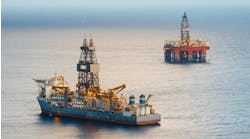Offshore staff
STAVANGER, Norway -- Statoil is looking to halve development time of some of its Norwegian marginal discoveries, according to a presentation today at ONS.
Staale Tungesvik, senior VP EPN Business Development, said the company’s overall goal was to maintain current levels of production on the Norwegian shelf for a further 10 years.
“That’s an enormous ambition. Increasing recovery from existing fields will remain a big contributing factor, but three-quarters of our new projects will be subsea, based on a few wells and a flowline tied into a platform. For that to work, we need to move away from tailor-made to ready-made solutions.”
Aside from the company’s large new standalone (platform-based) developments such as Gudrun (recently sanctioned), Valemon (sanction due this fall), Dagny and Luva, “all the rest in our portfolio are small, subsea tiebacks,” Tungesvik said.
A first group of four tieback programs under review as a “Wave 1” program include the recent discoveries Pan Pandora and Katla, both 60 MMboe prospects, which will be connected respectively to the Gullfaks C and Oseberg South platforms in the North Sea. Both should come onstream in 2012. Another priority is Gygrud in the Norwegian Sea, which could be produced via the Draugen complex.
“Wave 2” options include various accumulations in the Snorre area of the North Sea and near Norne in the Norwegian Sea, both of which have spare capacity. Specifically, Statoil is focusing on the 37-63MMboe Forsekall, discovered in the Norwegian Sea and Dompamp in the same area, which it hopes to bring on line in 2013.
“We have a lot of other interesting candidates in PL 303, a huge license in the Greater Sleipner Area,” Tungesvik added.
Statoil’s goal is to develop these marginal fields as subsea tiebacks within two and a half years of discovery, and if possible to shorten that time frame. Advance scheduling plays a big part: “Once we know the necessary time for delivery of equipment, we can allocate a rig to drill the wells, and schedule template, flowline installations and so on.”
Increasingly, Statoil is asking its suppliers for their needs and their advice, in an attempt to speed things up further.
“A lot of them bring experience from shallow water Gulf of Mexico, Dutch and UK North Sea projects. We can use that experience for our Norwegian developments.
“Suppliers also recommend ways of cutting costs, particularly by going for standardized subsea solutions. That way, they claim, they can cut down on re-engineering, and can give us better prices, as it becomes easier for them to produce this equipment cheaper. Some standardized solutions could be 30-40% cheaper.”
Tungesvik said Statoil has 60 small marginal projects in its portfolio, four times as many as 10 years ago. “But we have a huge advantage on the Norwegian continental shelf, because of our infrastructure ownership in all areas, and our logistics capability. So we can find solutions that others have problems finding.”
What Statoil cannot cut back on, a colleague cautioned, is the time taken to drill a structure and interpret seismic in order to build a better reservoir model. “The reservoirs are all different for each of these fields,” he pointed out.
08/24/2010


